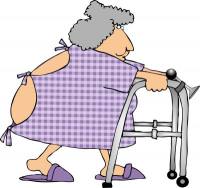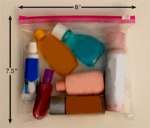|
Preparing For HospitalizationSpeaking both as a patient and a nurse, I know the importance of preparing for hospitalization. Whether you are going to the hospital for a same-day procedure or a longer stay, there are things you can do to make your life easier. The information provided here is based on experience as both a nurse and a patient, and should be used in addition to the instructions provided to you by your physician and your hospital. In order to make your preparing for hospitalization easier, this page is divided into:
Thanks to the internet, you can now find grocery stores which will allow you to shop online and have your groceries delivered right to your door. Many local grocery stores are now providing this service. E-Z Grocer.com within Canada or Schwan's within the United States are just two examples of national organizations which provide you with the ability to shop for your groceries from home and have them delivered to your door. Think ahead while preparing for hospitalization by either stocking up on pre-made meals or preparing simple meals before you go to the hospital. Should you need to go to your doctor and do not wish to "bother" your friends or family, you can contact your local taxi service or, you can contact your local hospital and ask for medical transportation services in your area. There are usually quite a few, very inexpensive services available. With so many resources available, there is no good reason for you to drive yourself anywhere before your doctor has provided you with his/her medical clearance. Dressing for the Hospital:Dress for comfort and ease, not fashion, when preparing for hospitalization. A nice, loose-fitting pair of sweat pants and zip-front sweat jacket are perfect fashion "do's" for going to the hospital, and for coming home as well.
Don't worry about bath robes or pajamas. Again, this isn't about fashion; it is about your health and safety. Hospital personnel may need to access your arms, legs and chest for heart monitoring (EKG), or intravenous access (IV). There are times when we have to cut the gowns. It is much easier to do all of this to a hospital gown! If you are worried about keeping your backside covered, the hospital has an ample supply of gowns to keep you free of drafts!!! Flannel bath blankets are also available to keep you warm and cozy. Just ask!
While adrenaline may help you make it from the hospital to your car, by the time you reach your home, you are exhausted. Wearing sweats or something similar eliminates the need to change into something more comfortable once you are home. What you should bring with you to the hospital and what you should leave behind:Whether you are going to the hospital for a day or a week, here are the things you should pack when preparing for hospitalization, and what you should leave behind in the order of their importance. Legal Documents:Hospitals require photo identification and confirmation of insurance. In preparing for hospitalization, you may wish to check with the admitting department before your arrival to see if they will accept copies (front and back) of these documents. This will allow you to keep the original documents safely at home! Be sure to bring a copy of your durable power of health/Advance Directives and HIPAA release form! With so many healthcare options, it is essential that you make your wishes known to those you love before they find themselves in a situation where they have to guess what you would want, in the event you are unable to speak for yourself. By putting your wishes in writing and discussing this ahead of time, you avoid the heart-wrenching guess-work your friends and/or family would otherwise have to face in the event of an emergency. Whether you are in the United States, Canada or any of the other countries who have adopted the Advance Directives forms, you can find free downloads of the forms by doing an internet search. Please be aware that each state (if you are living in the United States) or province (if you are living in Canada) has its own specific form. Be sure to update your form if you move out of state or country! Check out the reference section for several links where you can access free copies of Advanced Directive forms, which are state and province specific. In the United States, the Health Insurance Portability and Accountability Act (HIPAA), in addition to oaths taken by physicians, nurses and other health care workers, prohibits your health care team from discussing your medical information with anyone who is not directly involved with your care unless, when preparing for hospitalization, you have provided the medical staff with written permission. In the United States, this permission is provided in the form of a HIPAA release of information form. The HIPAA release form lists the person(s) or organization who you have authorized to receive clinical and/or claims information. Typically, the HIPAA release is related to a single event and is time limited. Here is how the HIPAA release would work for you: Without the HIPPA policy, you are admitted to the hospital for an emergency appendectomy. Before you were carried away by the paramedics, you left a message on your spouse's voice mail. Your spouse calls the hospital and asks the nurse for an update on your condition. The nurse is only able to say that you are resting. Your spouse is a bit upset, asking for more information about how the surgery went and, again, the nurse can only say that you are resting. With the HIPAA release: Let's say you were hospitalized in January for appendicitis. You provided the hospital and your physician with a HIPAA release of information form authorizing your spouse to receive clinical information and assist with any claims associated with your hospitalization. Your nurse understands that you have provided the hospital permission to speak to your spouse. When your spouse calls, the nurse is able to inform them that you appendix had ruptured but you were doing well. You are on intravenous antibiotics and will need to stay in the hospital for a few days. Remember, you need to provide a new HIPAA release form each time you are admitted to the hospital. Toiletries:
When preparing for hospitalization, resist the urge to bring a suitcase filled with toiletries and clothes. Instead, focus on the basics and keep it small: hair brush, trial-size toothpaste, toothbrush, and trial-size deodorant. Think TSA (Transportation Safety Administration) or trial-size. If your items can't fit it in a one quart bag, leave it home!
Please leave aerosol sprays, perfumes and petroleum products at home! In addition to the sprays causing breathing problems to those with respiratory conditions, these products are considered flammable. Oxygen is used throughout hospitals. While oxygen is non-combustible, it will ignite and cause combustible items such aerosols and perfumes to burn quicker and hotter. Electronic Devices:While the hospitals carefully inspect their own electric devices to insure your safety, they cannot guarantee the safety of your devices. For this reason, most hospitals do not permit the use of electric razors or blow driers brought from home. The number one rule is: only bring things you are willing to damage or lose. Things tend to get lost in among the supplies and equipment in your room and the shuffle of changing linen. The hospital's staff is looking out for you, not your MP3 player or digital entertainment devices. Cell phones are also on the "do not pack" list when preparing for hospitalization, for several reasons. The primary reason is again for your safety and the safety of those around you. Cell phone frequencies can interfere with heart monitoring equipment. Even if you are not in need of a heart monitor, out of respect and courtesy, please think of those who do require cardiac monitoring. Please also remind your visitors to refrain from using their cell phones during their visit with you. You never know. Someday you or one of your friends/family members may need heart monitoring and you will be begging others to show the same courtesy. The second reason for leaving your cell phone at home goes back to rule number one: only bring things you are willing to lose or have damaged. As a nurse, it is not my intention to pour water on your iPhone or lose your ear buds while I am providing you care. I am focusing on keeping you alive. If you chose to bring your electrical entertainment devices please remember you have been warned!!! It is your responsibility if something happens to your electronic equipment. A Check List, to Make Preparing for Hospitalization Easier:Here is a brief check list of things you should bring, things you should leave behind and things you "could bring", as you are preparing for hospitalization. Please click here if you would like to download a copy of this list, or go to our section on "healthcare forms" and feel free to download a copy. Before you go home, do a reverse check list. In other words, go through your list to make sure that the items which you brought with you to the hospital are going home with you!
To fit on this web page, the table is actually more narrow and longer than what you would download. The page you will use preparing for hospitalization fits on a standard 8.5" X 11" paper. To download the hospital checklist (or any of the forms), you must have Adobe® Reader® on your computer to view these forms. If you do not have this software, and would like a free copy of it, please click Food and Transportation:You should not drive until your doctor says it is safe to do so! It has been my experience that women are more likely than men to ask a family member or friend for assistance. I have heard a host of reasons why a person who has been recently released from the hospital has elected to drive themselves to the market, cleaners, doctors, ... The excuses range from "I didn't want to be a bother to my friends or family" to "I feel perfectly fine! I know my limits and I know I am safe to drive!" The reality is, you have an exaggerated sense of your skills and abilities after a hospitalization stay. You do not realize that, within three days of being in bed (whether at home or the hospital) you start losing a significant amount of muscle tone/strength. If you have undergone surgery, remember, you have had muscles pulled apart and cut. It takes at least two months for muscles to heal. Your reflexes may also be affected by medications you may be taking. The bottom line is, because your strength and reflexes are impaired, you could not only injure yourself but you could injure others. A Word About Hearing Aids, Glasses and Dentures:
My husband said it best when he described hearing aids, glasses and dentures as "tricky little devils." On one hand, they should be on your list of things to take with you to the hospital. After all, you need them in order for you to hear, see and eat! On the other hand, they can easily be lost and are rather expensive to replace. It is better to bring these items with you. Be sure to bring containers for each item. The containers should be large, making them harder to misplace. Don't forget to securely attach your name and phone number to the base of the containers as well, just in case! If you have a back-up pair of glasses, it may be wiser to leave your good pair at home and use your back-up pair while you are in the hospital. Resources to Help With Preparing for HospitalizationNo-Rinse Shampoo from Amazon.com. U.S. Living Will Registry: provides free state-specific Advance Directives. Caring Connections: provides free state-specific Advance Directives Forms. MegaDox: provides province-specific Advance Directives forms (for a small fee) for Canada. Caregivers Action Network: an organization within the United States which provides caregivers resources and support. Schwan's: order your groceries online and have them delivered to your home! This service is available within the United States. Online Shopping Guides: provides links to online grocery services within Canada, based on location of delivery. If you have children preparing for hospitalization, Amazon.com has several books for children aged 4-8 years of age. They include 'Franklin Goes to the Hospital' and 'Good-bye Tonsils'. Return to Going to The Hospital |









